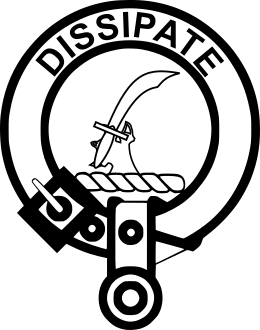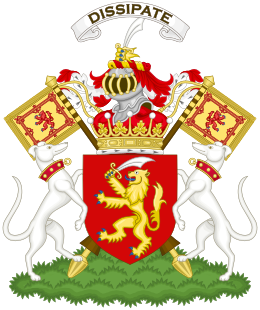Clan Scrymgeour facts for kids
Quick facts for kids Clan Scrymgeour |
|||
|---|---|---|---|

Crest: A Lion's Paw erased in bend Or holding a Crooked Sword or Scimitar Argent
|
|||
| Motto | Dissipate (Disperse) | ||
| Profile | |||
| Region | Highlands and east of Scotland | ||
| District | Fife | ||
| Plant badge | Rowan | ||
| Chief | |||
 |
|||
| Alexander Scrymgeour | |||
| The Rt. Hon. The 12th Earl of Dundee (Mac Mhic Iain) | |||
| Seat | Birkhill north of Cupar in Fife | ||
| Historic seat | Fincharn Castle Dudhope Castle |
||
|
|||
Clan Scrymgeour is a famous Highland Scottish clan. Clans are like big families or groups of people who share a common ancestor and often live in the same area. The Scrymgeours have a long and interesting history, especially known for being important banner bearers for the Scottish kings.
Contents
Clan History
Where the Clan Name Comes From
The name Scrymgeour likely comes from an old English word, skrymsher, which means a swordsman. This makes sense because the clan became known for its fighting skills. The Scrymgeour family was well-known in Fife, a region in Scotland, even before they became connected to the city of Dundee. Over time, the leaders of the clan were given important jobs, like being constables (officers who keep order) and royal standard bearers. This meant they had the important job of carrying the king's banner in battles and ceremonies.
Some historians believe the Scrymgeours might be related to the MacDuff Earls of Fife. It's thought that their role as standard bearers might come from ancient Celtic traditions. In those times, armies often carried sacred items, like staffs, which were looked after by special keepers. It's possible the Scrymgeours once carried a holy relic that later became a battle banner.
Fighting for Scotland's Freedom
During the Wars of Scottish Independence, the Scrymgeours played a brave part. They were officially confirmed as banner bearers by William Wallace and the Scottish Parliament in 1298. A man named Alexander Scrymgeour was one of the first to support Robert the Bruce in his fight for Scotland's freedom. Bruce even gave Alexander a special document confirming his rights, which is the only paper that mentions both Bruce and Wallace together.
Sadly, this brave Alexander Scrymgeour was captured by the English and hanged in 1306 by order of King Edward I of England. But another Alexander Scrymgeour continued the family's legacy. In 1314, he proudly carried the royal banner at the famous Battle of Bannockburn, where Robert the Bruce won a great victory for Scotland.
Later, in 1370, the Scrymgeour family gained a lot of land in Argyll when Alexander Scrymgeour married Agnes, who was the heir to Gilbert Glassary.
Growing Strong in the 1500s
In the 15th century, Clan Scrymgeour continued to do well. The seventh constable of Dundee bought the lands of Dudhope in 1495, which were close to the city. They later built Dudhope Castle there, which became the chief's main home until 1668.
Their lands in Argyll were managed from Fincharn Castle. In 1513, John Scrymgeour of Glassary marched from Fincharn to the Battle of Flodden, carrying the royal banner. He was badly wounded in this battle. The Scottish Gaelic name for Scrymgeour is Mac Mhic Iain. There's a local story that Fincharn Castle was burned down by an angry groom after an early Mac Mhic Iain tried to steal his bride!
In 1587, Sir James Scrymgeour received new official papers for his lands at Holyrood Palace.
The 1600s and Civil War
Sir James Scrymgeour (who died in 1612) was an important person. He was one of the people sent to Denmark to arrange the marriage of King James VI of Scotland to Princess Anne. He also helped discuss a political union between Scotland and England in 1604.
In 1617, Sir James's son, John Scrymgeour, welcomed King James VI to Dudhope Castle. In 1641, King Charles I of England made John a noble, giving him the titles of Viscount of Dudhope and Baron Scrymgeour of Inverkeithing.
During the Civil War in Scotland, the second Viscount of Dudhope fought for the Scottish Covenanters against King Charles I. He was badly wounded at the Battle of Marston Moor in 1644 and died. His son, also named John Scrymgeour, took over. This John commanded a group of royalist soldiers in 1648 and fought at the Battle of Worcester in 1651. He managed to escape after the king's side lost and joined another army in the Scottish Highlands, but he was captured in 1654. After the king was put back on the throne in 1660, John Scrymgeour was given the title of Earl of Dundee.
A Disputed Family Title
When John Scrymgeour, the Earl of Dundee, died in 1668 without children, his castles, lands, and royal jobs were taken by the Duke of Lauderdale. The Duke sent soldiers to take all of the Scrymgeour family's important papers. He then claimed there was no rightful heir, so the lands went back to the King. The Duke then got the King to give him the titles and lands, which he then gave to his own brother. These lands later went to John Graham, 1st Viscount Dundee, who died in battle in 1689. The lands were then taken by the government and later passed to the Douglases.
However, the titles should have gone to John Scrymgeour of Kirkton, who was a relative of the fifth constable of Dundee. His grandson, David Scrymgeour, who was a sheriff in Inverness, married Catherine, the daughter of Alexander Wedderburn. Their son took the name Scrymgeour-Wedderburn and inherited the Wedderburn family lands. But the Wedderburns kept fighting for their right to the old Scrymgeour titles.
At the crowning of King Edward VII, Henry Scrymgeour-Wedderburn carried the standard (banner) of Scotland. His grandson, another Henry Scrymgeour-Wedderburn, was finally recognized as the eleventh Earl of Dundee by the House of Lords. The eleventh earl's son is Alexander Scrymgeour, 12th Earl of Dundee, who is the current chief of Clan Scrymgeour.
Current Clan Chief
The current leader of Clan Scrymgeour is Alexander Scrymgeour, 12th Earl of Dundee. He has followed in his father's footsteps and is involved in politics in the House of Lords.
Clan Home
The main home of the Scrymgeour family is still at Birkhill, which is north of Cupar in Fife.
Clan Records
The historical records of the Scrimgeour Clan Association are kept at the University of Dundee.
See also

